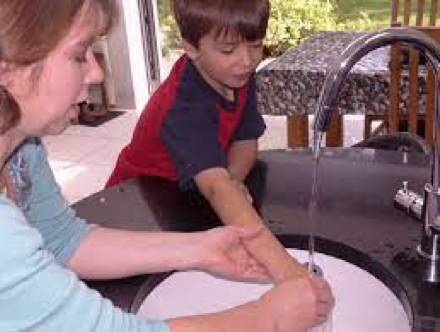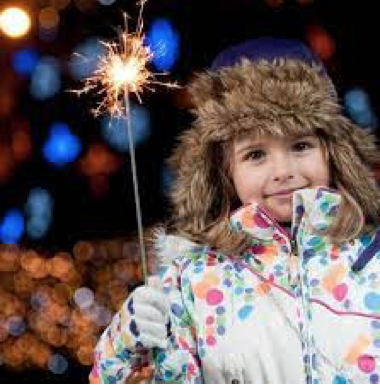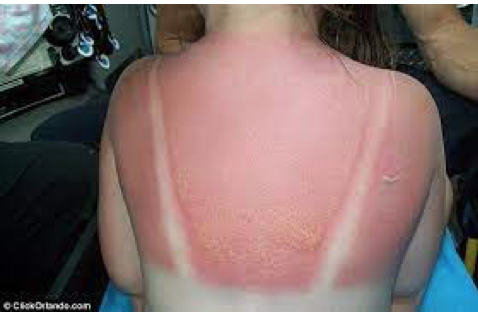By Registered Health Visitor – Julia Headland

Wednesday 13th October marked National Burns Awareness Day which is a day that aims to raise awareness of the shocking number of people that are burned in some capacity each day. To support this day, I have been asked by the nursery to write a blog about some different types of burns and how these can be treated in the first instance but also to look at recommendations for the prevention of burns and scalds.
Around 95% of all childhood burns and scalds happen at home and according to the Child Accident Prevention Trust (CAPT) (2021), most of these injuries occur during day-to -day situations that many parents do not anticipate such as burns from hot drinks of hair straighteners.
Both burns and scalds are damage to the skin caused by heat, the difference being that scalds are caused by something wet, for example hot water or steam and a burn is caused by something dry such as an iron or fire (Tinsley 2016). Burns can be extremely painful and may cause redness, peeling, blisters, swelling and even charred skin. Surprisingly though, the amount of pain felt does not correlate to the seriousness of the burn as some very serious burns may be relatively painless (NHS Choices 2016).
Hot Drink Burns
According to the Children’s Burns Trust (CBT) (2022), thirty babies and toddlers go to hospital every single day with a hot drink burn and the vast majority of these burns are preventable simply by keeping the child out of reach of a hot drink.
So, what should you do if your child receives a hot drink scald?
- Cool the burn with cold running water for 20 minutes and remove all clothes or jewellery unless it is stuck firmly to the wound. Do not use ice, butter, or any creams.
- Call for help for any burn larger than a 50p coin- either 999, 111 or GP depending on the degree of burn
- Cover the burn with cling film or a sterile, non- fluffy dressing. Alternatively, if the burn is to the hand, you can use a clean plastic bag.
- Make sure you keep the child warm.
- Use analgesia such as ibuprofen or paracetamol for symptom control.

Fireworks
It is that time of year again where many of us will be celebrating bonfire night with fireworks and sparklers, but did you know that the Children’s Burns Trust (CBT 2022) estimates that five hundred children and their families will remember Bonfire night because they will have been injured because of an accident with fireworks?
It is not just fireworks though, there is a myth that sparklers are a harmless way of allowing young children to participate in fireworks night, but did you know that a sparkler can reach temperatures of up to twenty times the point of boiling water? In view of this, the CBT (2022) have advised the following recommendations:
- Never give sparklers to children under the age of 5 years old
- Make sure that older children wear gloves to handle sparklers and always hold them at arm’s length.
- Always have a bucket of water to hand to put the used sparklers in (hot side down).
What to do if you or your child’s clothes catch fire:
STOP, DROP and ROLL
Your instinct may be to run and therefore it is wise to get your children to practice stopping, dropping to the ground, covering their face with their hands, and then rolling around a few times to put the flames out (CBT 2022)
For more information on safety around fireworks, you can read the “Child Accident Prevention Trust’s advice for more information around staying safe around fireworks.
Sunburn

So, we may be out of the season for sunburn but some of you may be taking a hot holiday this half term so just a quick reminder of measures to provide symptomatic relief of sunburn.
- Take a cool bath or shower
- Apply topical emollients
- Apply cold compress
- Take simple analgesia i.e., paracetamol or ibuprofen
- Keep your child hydrated
Of course, prevention is key so remember to cover up with suitable clothing and spend time in the shade especially between the hours of 11am to 3pm when the sun is at its strongest. When you are in the sun, wear at least SPF 30 and reapply every 2 hours.
When to attend A&E
For other types of burns, parents should be told to go to A&E in the following circumstances:
- All chemical burns (e.g., bleach)
- All electrical burns
- Large or deep burns, any burn bigger than the size of the child’s hand either as a single burn or the surface area of smaller burns added together.
- All circumferential burns (burns that go all the way around the surface of a limb or the body)
- Any sized burn that causes whiteness or charred skin
- Any burn on children under the age of 5 years
- Burns on the face (especially near or on the eyes), hands or across the joints must always be checked.
- Burns on the arms, feet or legs that cause blisters
- Any burns involving other injuries (such as crush injuries, fractures, or head injuries).
- Any minor burn that has not healed within 14 days.
(NHS Choices 2022)
Recommendations for the prevention of scalds and burns
- Keep toddlers out of the kitchen as much as possible
- Put a safety gate across the doorway to stop toddlers getting in
- Consider using a kettle with a short or curly lead to stop it hanging over the edge of the work surface
- When cooking, use the rings at the back of the cooker and turn the saucepan handles towards the back so the child cannot grab them
- Never leave a chid unattended in the kitchen
- Put irons, hair straighteners and tongs out of reach of children whilst they cool down as hair straighteners can burn for up to 8 minutes after they have been switched off
- Fit fire guards around fires and heaters
- Keep matches and candles out of reach
- Store chemicals, cleaners, and acids out of reach of children
- When running a bath, always put cold water in first and use your elbow to test the temperature of the water
- After warming a bottle of milk, shake the bottle well and test the temperature of the milk by placing a few drops on the inside of your wrist, it should feel lukewarm not hot
- Never allow a child to drink a hot drink from a stra
———End———
For those people I have not yet met, my name is Julia Headland and I am a registered health visitor and registered general nurse with a degree in public health and over 20 years of experience. I am very pleased to work alongside the Norfolk House Nursery team.
You can arrange to meet me for confidential advice or guidance about your child’s health or development; during the pandemic these consultations are being conducted by Zoom or telephone.
My consultations are free of charge and they are confidential.
You can book an appointment with me via the Norfolk House Nursery staff.
You can also follow me on social media:
Facebook: @JuliaHeadlandPrivateHealthVisitor
Instagram: jh_privatehealthvisitor
